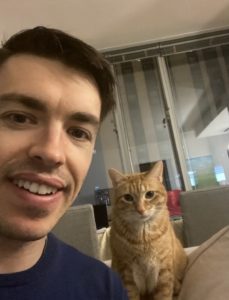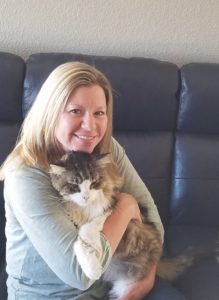Kim Campbell Thornton
Blood draws, chemo, happy vet visits, even training veterinary students: Fear Free makes things work. Here are this month’s success stories.

Kim Campbell Thornton
Blood draws, chemo, happy vet visits, even training veterinary students: Fear Free makes things work. Here are this month’s success stories.
Indy was a middle-aged mixed-breed dog who developed Stage 3a lymphoma requiring weekly treatment under a CHOP chemo protocol. Only one problem: he was an FAS 4-5 patient who did not like to be touched, let alone restrained. How were we going to treat weekly with IV catheter-administered chemotherapy? Spent a lot of time in the early days fine-tuning a PVP protocol that allowed us to work on touch gradient approach so we could eventually hold his paw and use a regular or butterfly catheter to administer therapy. We always had myself and one specific technician available to work on desensitization with gentle restraint and forelimb holding. Lots of treats. For longer IV treatments, we preemptively sedated Indy. By the end of his treatment cycles, he would walk into the chemo room, sit or lie on a padded mat, and let us treat without incidents. Amazing! It works!
Jeffrey D. Palmer, DVM, Elite Fear Free Certified Professional, Burr Ridge Veterinary Clinic, Darien, Illinois
 A new feline patient with a high level of fear, anxiety, and stress went home with gabapentin as a pre-visit pharmaceutical. The exam we performed two days later was great. He was readily eating tuna and happy to be petted. He did well for a complete exam, including radiographs and blood draw. The Feliway-infused towel was also a great help.
A new feline patient with a high level of fear, anxiety, and stress went home with gabapentin as a pre-visit pharmaceutical. The exam we performed two days later was great. He was readily eating tuna and happy to be petted. He did well for a complete exam, including radiographs and blood draw. The Feliway-infused towel was also a great help.
Matthew Hudson, DVM, Elite Fear Free Certified Professional, VCA Blum Animal Hospital, Chicago, Illinois
We have seen so many success stories with numerous patients, but the best for me is my personal cat. He is an uncontrolled diabetic, and the first year I owned him he had a lot of blood draws and vet visits. He was a wonderful-tempered cat at home, but at the clinic, while he never bit or scratched, he hissed and struggled every time he came out of the cage and became a difficult patient to handle. He is very food-motivated and after we started Fear Free practices and he got squirt cheese and baby food every time he was handled, he now purrs and rubs on everyone when he comes for treatments and is so much happier and easier to handle. I am overall so much more aware of a patient’s anxiety level the moment they walk in the door now, and it gives us a chance to start finding ways to alleviate their stress before it escalates.
draws and vet visits. He was a wonderful-tempered cat at home, but at the clinic, while he never bit or scratched, he hissed and struggled every time he came out of the cage and became a difficult patient to handle. He is very food-motivated and after we started Fear Free practices and he got squirt cheese and baby food every time he was handled, he now purrs and rubs on everyone when he comes for treatments and is so much happier and easier to handle. I am overall so much more aware of a patient’s anxiety level the moment they walk in the door now, and it gives us a chance to start finding ways to alleviate their stress before it escalates.
Cheri Crane, Elite Fear Free Certified Professional, Customer Service Representative, Healing Paws Veterinary Clinic, Springfield, Missouri
For most of my practice career, I have been involved in student training. Some students embraced the things I taught them about the importance of minimizing fear, anxiety, and stress in patients, while others felt I was “too soft,” “only cared about giving the animals treats,” or “was crazy or misguided in my efforts.” Fellow faculty members sometimes shared these sentiments and even accused me of not being able to “get the job done” when I would elect to postpone or re-plan a procedure for an animal. The revolution of awareness that Fear Free has helped to create in our profession has changed the way I am viewed by students and colleagues. No longer the “crazy Dr. Griffin,” I am the one they ask to teach them about low-stress handling and Fear Free techniques. The art and science of Fear Free have become valued: this is truly a gift for all of us, our patients, and their owners. I look forward to the day when Fear Free is taught in all veterinary colleges and is fully embraced as an indispensable standard of care in veterinary practice.
in patients, while others felt I was “too soft,” “only cared about giving the animals treats,” or “was crazy or misguided in my efforts.” Fellow faculty members sometimes shared these sentiments and even accused me of not being able to “get the job done” when I would elect to postpone or re-plan a procedure for an animal. The revolution of awareness that Fear Free has helped to create in our profession has changed the way I am viewed by students and colleagues. No longer the “crazy Dr. Griffin,” I am the one they ask to teach them about low-stress handling and Fear Free techniques. The art and science of Fear Free have become valued: this is truly a gift for all of us, our patients, and their owners. I look forward to the day when Fear Free is taught in all veterinary colleges and is fully embraced as an indispensable standard of care in veterinary practice.
Brenda Griffin, DVM, DACVIM, Elite Fear Free Certified Professional, Adjunct Clinical Associate Professor of Shelter Medicine, Maddie’s Shelter Medicine Program, University of Florida College of Veterinary Medicine, Gainesville, Florida
I took a client’s puppy to our veterinary office for a happy visit after the previous appointment did not go well for them. We played on the floor, showed off some of their tricks, ate some really yummy food. I was able to ask for a nose target to get up on the scale all on his own! We were able to leave with a calm, happy puppy and his next vet visit went much better.
Jenn Hauta, Elite Fear Free Certified Professional, Fairy Dogmother Training & Pet Care, Nanaimo, British Columbia, Canada
This article was reviewed/edited by board-certified veterinary behaviorist Dr. Kenneth Martin and/or veterinary technician specialist in behavior Debbie Martin, LVT.
Action Required! Your Membership has expired
Renew yourself by clicking Renew on My Homepage
Team Members, please tell your Team Admin
Students, apply here to renew your membership
Why?
Renewing and keeping an active membership is one of the requirements to maintaining your certification as well as access to member benefits.
Need help? Please contact our Customer Experience team at wags@fearfreepets.com or call us at 303.952.0585 and we will be happy to assist!
Go to My Homepage
Action Required: You Were Removed from Your Fear Free Team
Update account information by clicking here to go to your account info.
Please note: If you were recently removed from your Fear Free team, your membership will either expire 90 days from the removal date or expire at your current membership renewal date, whichever comes first. Already renewed? Update your account information through the link above. You will continue to receive this notice until your company information has been updated.
Need to join a different Fear Free team or have questions?
Please contact our Customer Experience team at wags@fearfreepets.com or call us at 303.952.0585 and we will be happy to assist!
Go to My Homepage